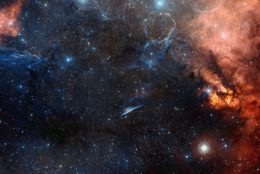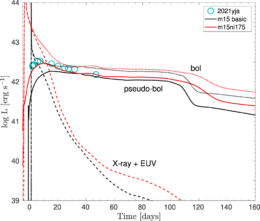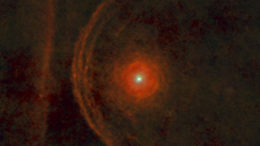Supernovae show a wide variety of behaviors as they fade, and these behaviors encode information about the exploding star and its surroundings. Can simulations help us understand why some supernovae maintain the same brightness for weeks or months?
Light Curve Characterization

The Pencil Nebula, located at the center image, is thought to be evidence of a shock wave created by a supernova. [ESO/Digitized Sky Survey 2; Acknowledgment: Davide De Martin; CC BY 4.0]
In a recent publication, Alexandra Kozyreva (Max Planck Institute for Astrophysics, Germany) and collaborators modeled supernova SN 2021yja to understand if its light curve can be explained by this emerging picture of Type IIP supernova evolution.

A comparison of the observed brightness of SN 2021yja (cyan circles) with modeled light curves for a model with (m15ni175; red) and without (m15 basic; black) circumstellar material. [Kozyreva et al. 2022]
Plateau Possibilities
Kozyreva and collaborators modeled SN 2021yja as a collapsing 15-solar-mass red supergiant — a star so large that it would engulf Mercury, Venus, Earth, and Mars if placed in our solar system. To test the impact of circumstellar gas on the exploding star’s light curve, the team compared models that incorporated a cloud of dense, hydrogen-rich material surrounding the star to those that didn’t. These simulations showed that circumstellar material is necessary to explain several features of SN 2021yja’s light curve, including its rapid rise and high peak brightness.
The best-fitting models incorporated 0.55 solar mass of surrounding material that extended from very close to the star’s surface out to 2,700 solar radii, and several facets of the model output indicated that this gas was distributed asymmetrically around the star. Given the density and proximity of the surrounding gas, the team found that the material was likely expelled in the span of just a few years. These results confirm that SN 2021yja fits the emerging picture of Type IIP supernovae, but they raise new questions about the source of the material in the star’s neighborhood.
Outflow Options
Kozyreva and coauthors outlined several possible sources for this material:
- Stellar winds. Red supergiant stars produce vigorous stellar winds, but these winds typically expel material at a rate 100,000 times slower than necessary for stellar winds to explain the predicted amount of circumstellar material.

Red supergiant star Betelgeuse, pictured here in an infrared image from the Herschel Space Observatory, has ejected a considerable amount of material. [ESA/Herschel/PACS/L. Decin et al]
- Binary interaction. If the star had a binary companion, the circumstellar material could have been generated by an enormous transfer of mass — large enough that it destabilizes the system and causes the stars to merge. However, this scenario likely causes less than one in 10,000 supernovae.
- Convective behavior. The atmospheres of red supergiant stars undergo a slow churning motion called convection, which creates the conditions for gas in the star’s atmosphere to be lofted upwards and eventually lost. The gravitational tug of a binary companion could cause this mass loss to be asymmetrical.
The team suggested that convection in the star’s atmosphere is the most likely source of the gas surrounding SN 2021yja — and since convection is common in red supergiant stars, it may provide an explanation for the curious light curves of many Type IIP supernovae.
Citation
“The Circumstellar Material around the Type IIP SN 2021yja,” Alexandra Kozyreva et al 2022 ApJL 934 L31. doi:10.3847/2041-8213/ac835a

